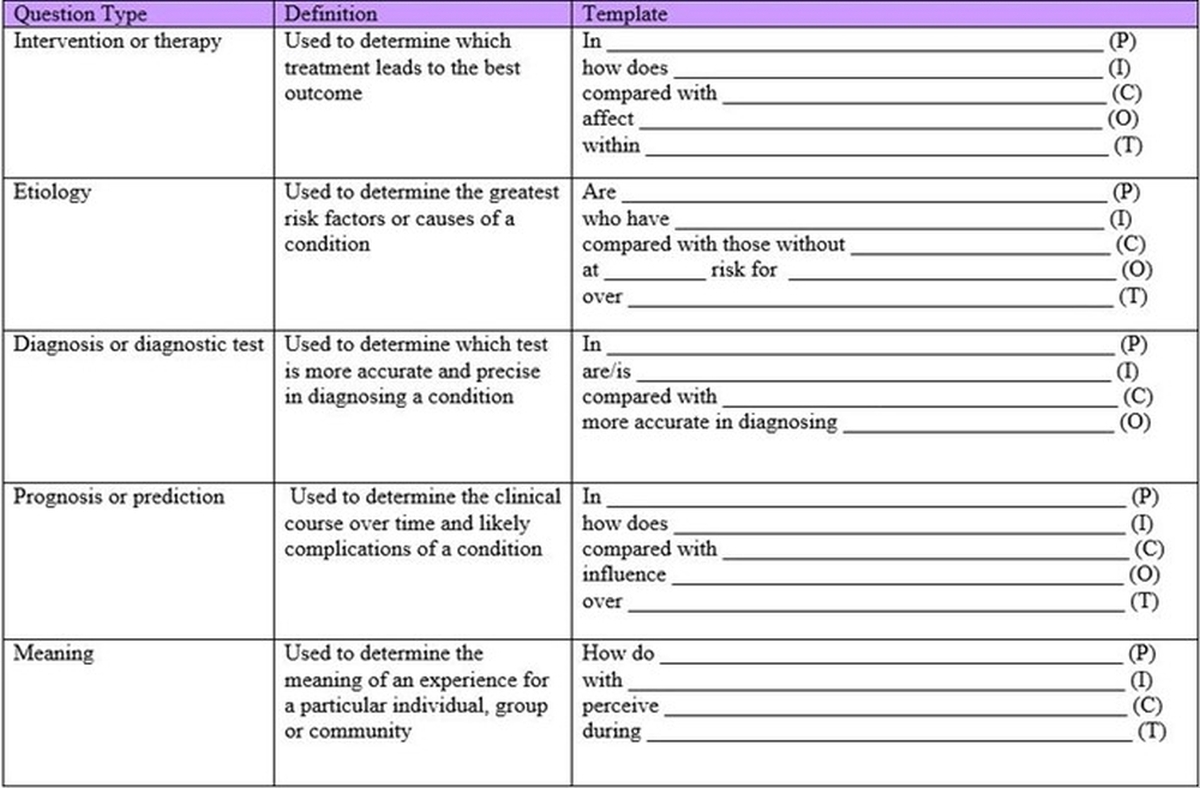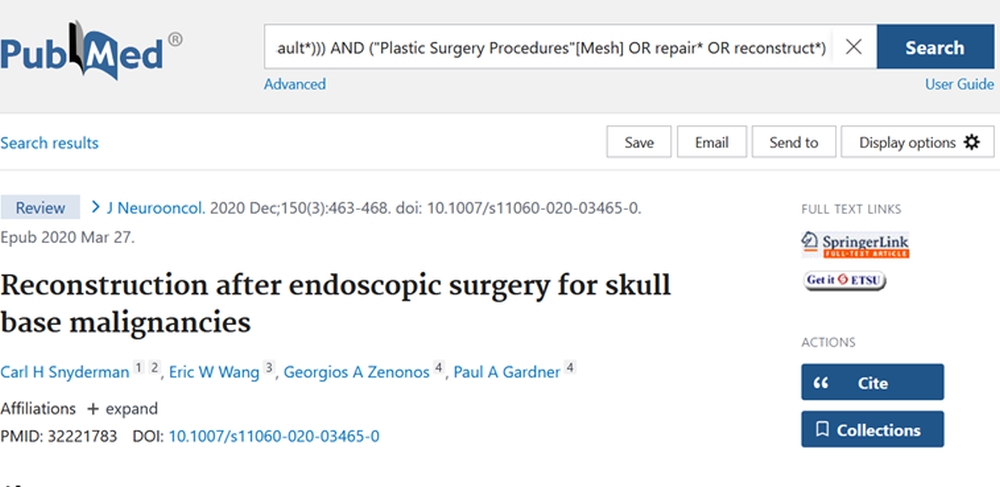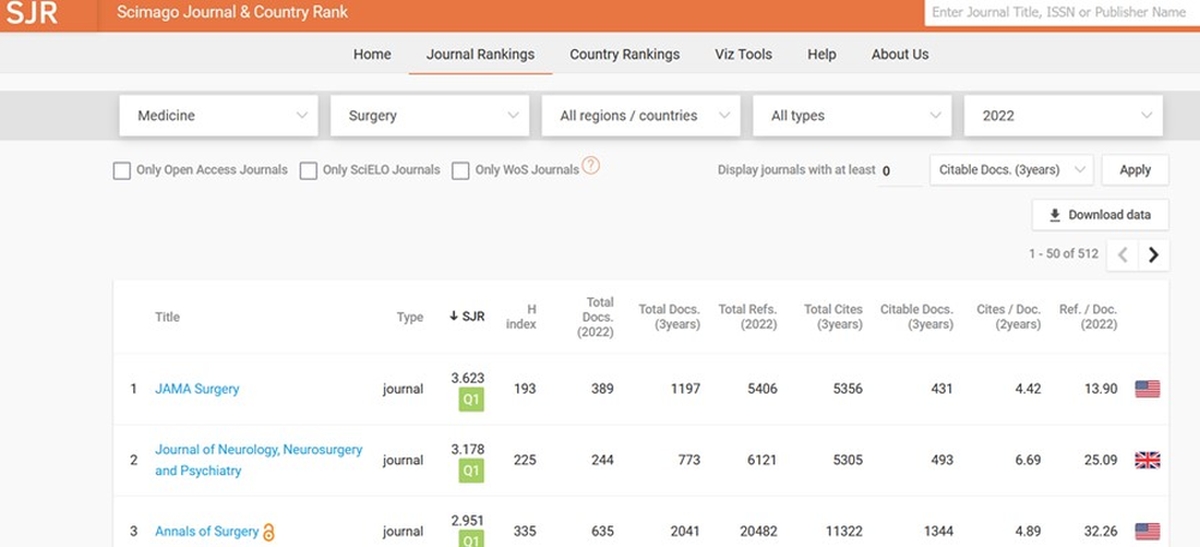1. Formulating a strong research question
When forming a good research question, keep in mind acronyms FINER and FINERMAPS1
FINER:
- Feasible
- Interesting
- Novel
- Ethical
- Relevant
MAPS:
- Manageable
- Appropriate
- Potential value and publishability
- Systematic
- Ratan SK, Anand T, Ratan J. Formulation of Research Question - Stepwise Approach. J Indian Assoc Pediatr Surg. 2019;24(1):15-20. doi:10.4103/jiaps.JIAPS_76_18
If you do not have a question that does not meet the criteria for FINER, you may consider changing or adding to your question for it to meet the criteria more clearly.
Once you have a question that you believe will be worth pursuing, you may use PICO(T) as a tool to frame your question for greater searchability.
PICO(T)
- Patient/Population
- Intervention
- Comparison/Control
- Outcome (desired or of interest)
- Time
There are many ways to phrase a question using PICO(T). The following table provides example templates that may help you put your question in a more searchable format according to question type.

“Evidence Based Practice, PICO(T): Definitions and Examples.” UVA Health Claude Moore
Health Sciences Library, 13, August. 2024, https://guides.hsl.virginia.edu/c.php?g=921177&p=6638623
Example – Question Type Therapy
Scenario: You have a female patient who has recently been diagnosed with SLE. Her rheumatologist suggested she start on Plaquenil for her joint pain, but she is interested in alternative therapies because she heard about success a neighbor had with turmeric tea.
P- patients with SLE
I- turmeric tea
C- Plaquenil (standard drug therapy)
O- reduction of joint pain
Question: In adult patients with SLE, is consuming turmeric tea more effective than Plaquenil at reducing joint pain?
This question could be more specific (Gender specific? What counts as a reduction in joint pain?) but is still a therapy question. We're comparing an alternative therapy (turmeric tea) with a more standard drug therapy (Plaquenil).
For this example and more go to: https://guides.hsl.virginia.edu/c.php?g=921177&p=6638623
2. Choosing appropriate databases
Once you have your search in PICO(T) format, you’ll want to choose appropriate databases to search in. For you these may frequently be:
- PubMed
- The includes Medline, the premier medical database, as well as additional information.
- CINAHL
- A nursing database with supplementary information that is not always in PubMed.
- Cochrane Databases
- Depending on the type of articles you’re looking for you may search in Cochrane Systematic Reviews (CDSR), Cochrane Central Register of Controlled Trials (CENTRAL), or Cochrane Methodology Register (CMR)
- SPORTDiscus
- Sport, fitness, sports medicine, and related discipline articles that are not always found in PubMed.
3. Formulating a search / getting help with searching
The actual lit search can be one of the more complex aspects of this process as different databases use different controlled vocabulary and structure their searches in different ways. Of course, you can always perform a simple keyword search in any database; however, this may not provide you with the quality or type of results that you need.
The example below showcases the same search translated across several databases with different numbers of results. The search topic was related to anterior midline fractures and gathering all of the articles related to the reconstructive surgical process for these fractures. You can see that the search has three main term categories – anterior midline – skull fracture/trauma/defect – reconstruction/repair – but they are phrased/formatted slightly differently depending on the database searched.
If you are unsure about how to perform a search, do feel free to reach out to the library at medref@etsu.edu, or to contact one of our librarians directly for assistance.
If you are seeking to publish, some journals do request to see the full literature search strategy used and may ask questions about the search recall. This is something that we can help you build so that these questions are easy to answer and your use of the literature is justifiable.
4. Accessing articles
If you have found an article via an ETSU database, accessed via the medical library website, you should be able to see a link to our catalog affiliated with the article (Get it @ ETSU, shown on next page).
Upon clicking this link you should be directed to the PDF for the article, or the library catalog if we do not have access to the article. If we do not have access to the article you may order it through Interlibrary Loan at no cost.

5. Appraising articles
Depending on the type of research you’re doing you may find a need to formally appraise articles. There are several tools to use that will walk you through this process. This page from London’s Global University provides links to several analysis tools.
The type of tool that you use may depend on your need. For example, the CASP Appraisal tools are very user friendly and may be great for a journal club setting; however, if you are reviewing articles on a systematic review level you may consider using a tool like GRADE or CerQUAL.
6. Choosing a journal for publication
You may wish to choose a journal to target for publication prior to writing your actual article. The reason for this is the instructions for authors can vary depending on journal. Of course, should you choose to change your target journal you can always modify things, such as citation style and word limit, but it is useful to have some parameters to start with.
Tips for choosing a journal include considering the impact of the journal, the type of audience you would like to target, and the difficulty of publishing in the journal. High impact journals are read by more people and are generally more difficult to publish in; however, publishing in a journal with a lower impact is not necessarily a bad thing, especially if the journal has a more niche topic and is innately read by fewer people due to the more obscure nature of the journal. Rather than worrying about impact as the most important factor for an initial publication, you may consider things like if journal is peer reviewed, if it’s indexed in Medline, and if it offers open access options so that more readers can search for and find your article efficiently.
The following tools will suggest journals to you based upon keywords in your abstract:
- Journal/Author Name Estimator (Jane): http://jane.biosemantics.org/
- EndNote matching feature: https://access.clarivate.com/login?app=endnote (must have a free EndNote Web account to use)
- Edanz Journal Selector: http://www.edanzediting.com/journal_selector
- Elsevier Journal Finder: http://www.elsevier.com/journalauthors/home#publishing-process
- Springer Journal Selector: http://www.springer.com/authors/journal+authors/helpdesk?SGWID=0-1723213-12-817204-0
Scimago (https://www.scimagojr.com/) shown below, shows you journal rankings and impact by discipline.

7. Writing tips
Aside from the information for authors provided by the individual journal that you have chosen to aim your publication for, there is also a series of writing tip articles from the Journal of Clinical Epidemiology that walk writers through the writing process including checklists for every step of the way.
- Writing Tips Series: https://www.sciencedirect.com/journal/journal-of-clinical-epidemiology/collection/10198X686V9
Other recommended articles include:
- Cohen H. How to write a patient case report. Am J Health Syst Pharm. 2006 Oct 1;63(19):1888-92.
doi: 10.2146/ajhp060182. PMID: 16990637.
- Benitez Sanchez S; AWS Publications Committee. How to write a case report/series. Am J Surg. 2023 Dec;226(6):926-928. doi: 10.1016/j.amjsurg.2023.07.005. Epub 2023 Jul 10. PMID: 37468386.
8. Citation management
While writing your paper you may want to choose a citation management tool. This is especially relevant if you are citing many papers. Specific citation management instructions are discussed more thoroughly in other how-to documents; however, the main notion is that you will want to choose a product such as EndNote or Mendeley to manage your citations. There are free and paid versions of both products that have specific tutorials associated with them.
9. Other topics of interest
- Predatory publishing:
- Refers to fraudulent publishers who pose as producers of legitimate academic journal
- Predatory publishers prey on potential authors for publication fees. Always think critically and thoroughly research a journal before publishing with them. One sign of authenticity is that a journal is indexed in Medline (in PubMed); however, not all legitimate journals are indexed in Medline and not everything indexed in Medline should be blindly trusted.
- Refers to fraudulent publishers who pose as producers of legitimate academic journal
- Be wary if a journal requires a hefty fee in exchange for publication. Know that some journals do legitimately ask for fees for open access publishing, as your fee offsets the
loss they incur by offering your article for free to the public; however, it is good
practice to think critically when choosing journals to submit publications to. Ask clarifying questions and contact editors if you doubt
the authenticity of a journal.
- Eriksson S, Helgesson G. The false academy: predatory publishing in science and bioethics. Med Health Care Philos. 2017;20(2):163-170. doi:10.1007/s11019-016-9740-3
- Open access
- Theoretically refers to articles and journals that publish scholarly articles that
are free to the public. There are many types of open access, including journals that
agree to immediately release your article to the public, those who agree to release
it after a period of time (embargo), etc. Review specific journal author sections
for their open access information.
- Publishing in open access journals allows more people to find, read, and cite your
article efficiently. It may not always be feasible to publish in open access journals,
especially if there is a fee involved. Note that some institutions offer grants for
authors to publish their articles as open access publications.
- For more information on types of Open Access, see this libguide provided by Cornell:
- Theoretically refers to articles and journals that publish scholarly articles that
are free to the public. There are many types of open access, including journals that
agree to immediately release your article to the public, those who agree to release
it after a period of time (embargo), etc. Review specific journal author sections
for their open access information.
 Stout Drive Road Closure
Stout Drive Road Closure